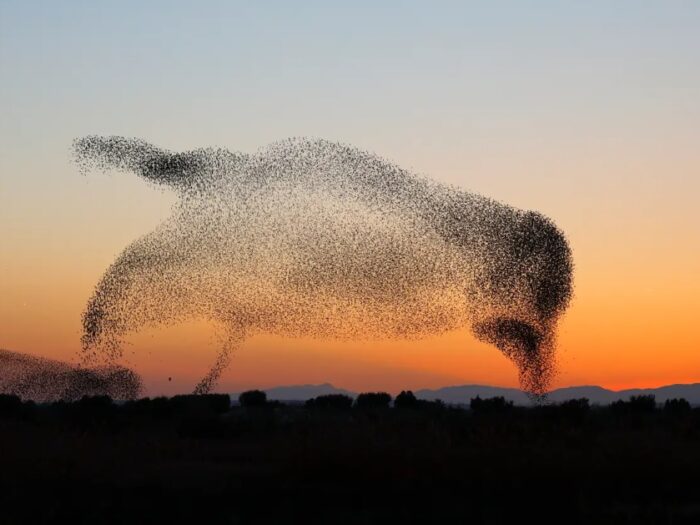Apr 26 2024
The Physics of Flocks
 Most people have watched large flocks of birds. They are fascinating, and have interested scientists for a long time. How, exactly, do so many birds maintain their cohesion as a flock? It’s obviously a dynamic process, but what are the mechanisms?
Most people have watched large flocks of birds. They are fascinating, and have interested scientists for a long time. How, exactly, do so many birds maintain their cohesion as a flock? It’s obviously a dynamic process, but what are the mechanisms?
When I was young I was taught that each flock had a leader, and the other birds were ultimately just following that leader. When two smaller flocks combined into a larger flock, then one of those leaders become dominant and takes over the combined flock. But this explanation is largely untrue. It actually depends a great deal on the species of bird and the type of flock.
The “follow the leader” method is essentially what is happening with the V formations. These are obviously very different from the murmurations of small birds morphing like a giant flying amoeba. Some species, like pigeons, use a combined strategy, still following a leader, but more of a hierarchy of leaders, which can change over time.
For the more dynamic flocks, like starlings, researchers found that there is no leader or hierarchy. Every bird is just following the flock itself. It is a great example of an emergent phenomenon in nature. It’s like ants working in a colony or a bee hive – each individual bee or ant does not really know what the entire colony is doing, and there is no leader or foreman calling the shots or directing traffic. Each individual is just following a simple algorithm, and the collective complexity emerges from that.
What, then, is the algorithm that the birds are using to generate flocking behavior? Going back to the pre and early scientific era, naturalists actually speculated that these large bird flocks used some form of direct communication – even raising the possibility of bird telepathy. But it does not appear that birds are communicating with each other, and there is no telepathy, bird or otherwise. By the 1980s, using computer simulations and high-speed camera observations, scientists started to formulate the rules of large flocks. It seems that flocking behavior can emerge from three simple bird behaviors.
First, each bird tries to avoid collisions with all its neighbors. Second, each bird will be attracted to other birds of the same species. And third, each bird will fly in the same general direction as the rest of the flock. Scientists discovered other rules for special situations. For example, when a predator attacks, individual birds try to fly toward the middle of the group for protection.
While these rules produce a reasonable approximation of large bird flocks, it was also clear this was not the entire answer. There is another layer here, other than just bird behavioral algorithms. That layer is the physics of flight and aerodynamics. A recent study looks at flow dynamics of flocking behavior, adding some additional insight into the behavior of flocks. They used mechanical birds in water to test the effects of the flow of fluid of each bird’s flying, and how that affects other birds in the flock.
For small groups, flow dynamics will tend to push birds into an optimal aerodynamic pocket. This is like drafting, and we already knew that birds do this. Those V formations are all about optimizing this effect to make flying more efficient. In the case of more dynamic flocks, the flow dynamics act like little springs, keeping each bird in the right place and avoiding collisions. If a bird gets out of line, the air flow will tend to push them back into place.
This makes the behavioral algorithm even simpler – you don’t have to simultaneously follow the flock while avoiding collisions. You just have to follow the path of least resistance, and if you stray you will be pushed back into place.
However, the researchers also found that when flocks get larger and larger, the flow dynamics change, creating more vortices and turbulence. These increase in a cascading effect from the front of the flock back, and eventually would lead to birds crashing into each other. It doesn’t seem like the researchers completely solved this problem, but they did show one possible solution. If you introduce a little variability into the behavior of each bird (so they are not perfectly in position) then this will tend to disrupt the amplification of turbulent flow, allowing for larger flocks without collisions.
Perhaps this is how bird flocking behavior evolved. First behavioral algorithms allowed for small flocks for mutual protection and warning from predators. And then evolutionary tweaks to the bird behavior algorithms allowed for larger and larger flocks over evolutionary time. And of course this only happened in some species. Others evolved other flocking behavior, or not flocking behavior depending on where they were in the predator-prey dynamic.
Still it seems like there is more to learn about large bird flocks, which at this point appears to be a dynamic interaction between behavior and physics. This is both more complex and more elegant than the quaint notions of the past.






